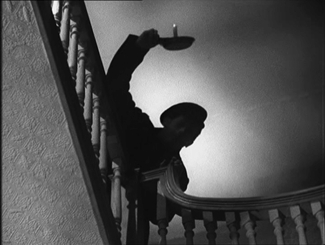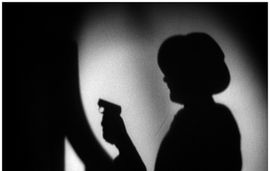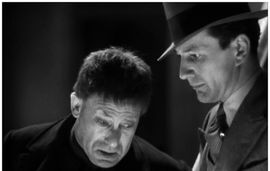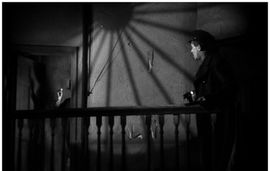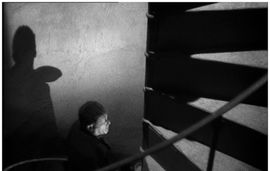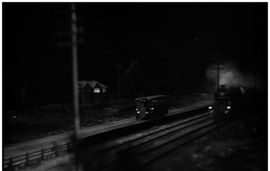This review from the August 1975 Monthly Film Bulletin (vol. 42, no. 499) probably features my first use of the word “diegesis“, which I must have learned about very shortly before. (As I recall, it was Laura Mulvey who explained to me what the term meant.) I’m not at all confident now that I absolutely had to use it.
An email sent on 9/4/09 from Adrian Martin: “Great to re-read your MFB pieces, which were among the earliest writings of yours I encountered as they appeared ! But your memorable NUMBER 17 piece raises a great historic mystery that has often plagued me, and which (I now realise) you may be at the centre of !! And that is the mysterious (mis)spelling of ‘diegesis’ – that is definitely the correct spelling, via the Greek root – as ‘diagesis’, which (as I recall) ran rife through FILM COMMENT and SIGHT AND SOUND for a while in the mid to late 70s (after a while, it seemed like some editorial superimposition by Corliss or Houston or whomever). It seemed to me, at the time, as the biggest symptom of the non- communication between film journalism and the theory academy! But maybe you have another version of where ‘diagesis’ came from ?? Any illumination will be greatly appreciated ! (Because this misspelling still crops up in student essays in 2009, fuelled by the reading of magazines from that period !!)”
I wish I could furnish a useful answer to Adrian’s query, but for the present, at least, I can’t. Perhaps I was carrying over a typo from Screen or elsewhere, and perhaps the fault was entirely my own — or that of one of my editors or proofreaders at the time. In any case, my apologies, but I’m letting this error (as well as Adrian’s correction) stand here as an illustration of the chaotic way so much of the history of film criticism still gets written (and recycled).–J.R.
Number Seventeen
Great Britain, 1932 Director: Alfred Hitchcock
“Well, come on. What about it?” “What about what?” This emblematic exchange, along with the opening shot -– the camera tracking with the wind past a ruffled tree to pursue a rolling hat, which is pursued in turn by a man who stops to retrieve it in front of an abandoned house –- helps to establish Number Seventeen as a compulsive flow of interlocking pieces and events, a kind of delirium of continuity that Hitchcock imposes on a rather humdrum mystery plot. The last film that he directed for British Lion at Elstree Studios, it is not one of his personal favorites; in his interviews with Bogdanovich and Truffaut, he terms it “another stage play that they’d bought…[which] didn’t transfer” and “A disaster!” respectively. Understandable verdicts, under the circumstances; yet the peculiar interest and excitement of this slim featurette today largely derives from the apparent impatience Hitchcock felt with his material. Hurtling through the complicated plot at so rapid a pace that irrelevancies, gaps in logic, revelations, and successive developments all seem to have an equal part in the diegesis, Hitchcock abstracts this tale of slippery identities into a giddy racing exercise, with momentum and surprise often taking precedence over rhyme or reason. A jewel thief makes a threatening gesture, then gratuitously sneezes; Hitchcock abruptly cuts to shadows on a wall, and elsewhere replays an idea from Murder by inserting a barrage of brief and consecutive close-ups; a woman introduced as deaf and dumb begins to speak, with no explanation given for either the deception or her abandonment of it. Working close to the edge of incoherence most of the way — an impression undoubtedly reinforced by the absence of five minutes in the print under review — Number Seventeen occasionally suggests a counterpart to Renoir’s La Nuit du Carrefour in its obscure network of nocturnal grapplings and multiple character reversals. Leon M. Lion, the producer and star, seems as much a liability as an asset to the proceedings because Hitchcock never appears to know quite how to integrate the actor’s stagey Cockney turns into the surrounding confusion; but there is one elegant moment –- Ben peeping ostentatiously at Sheldrake in the lavatory -– when actor and director are clearly working together, and one is reminded of a caricaturist side of Hitchcock which links him with Eisenstein. Although the movie seems to be remembered today chiefly for its concluding chase of model bus after model train, before the latter crashes into a model ferry –- a sequence which Claude Chabrol and Raymond Durgnat have each aptly compared to Jiri Trnka’s puppet films –- it is worth noting that Hitchcock handles the entire film like a mechanical toy, a top to be kept spinning at all costs. Only when the mechanism begins to run down, when the belated denouements and identifications begin to come to the fore and plot assumes a more conventional lucidity, does it become apparent how much the film’s execution has concealed a very pedestrian thriller framework.
JONATHAN ROSENBAUM

